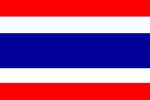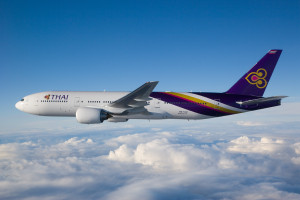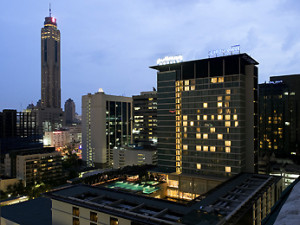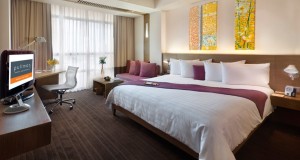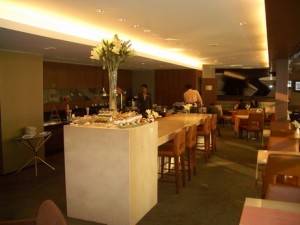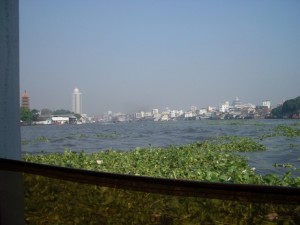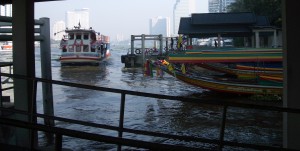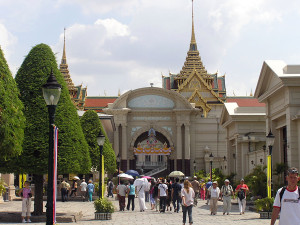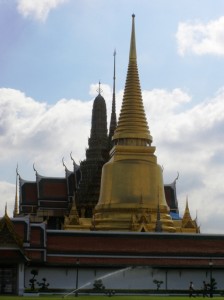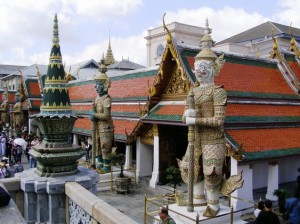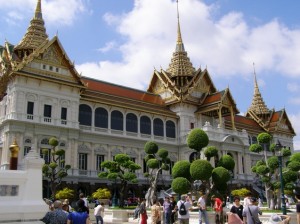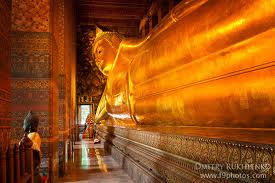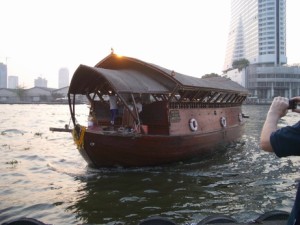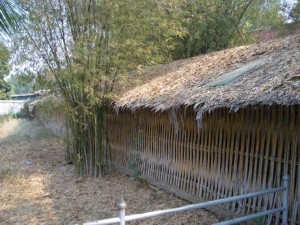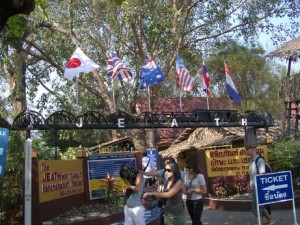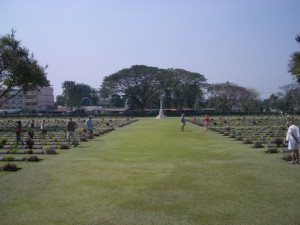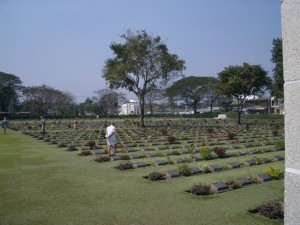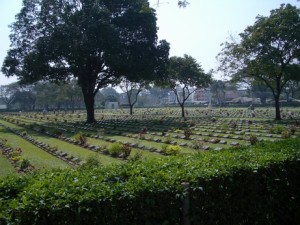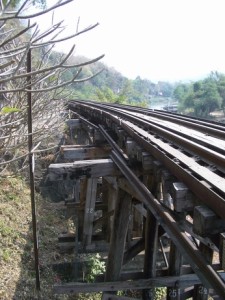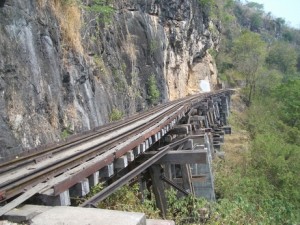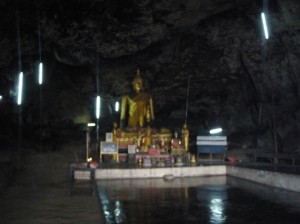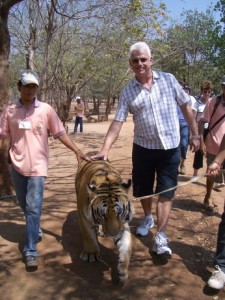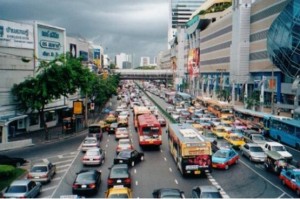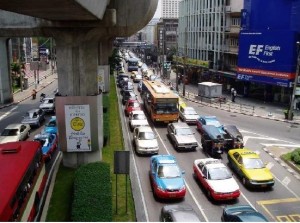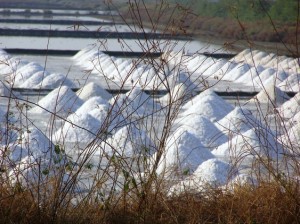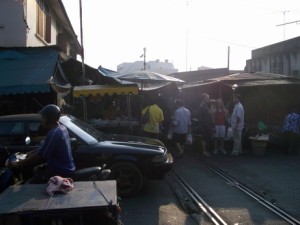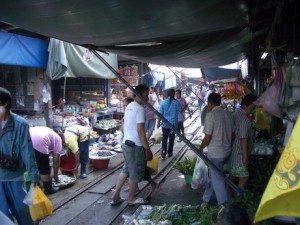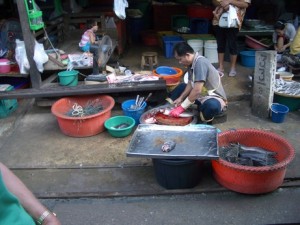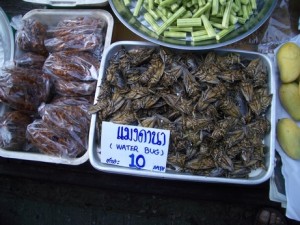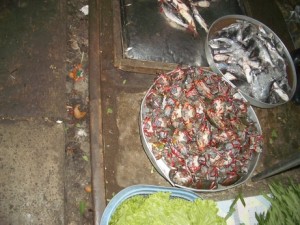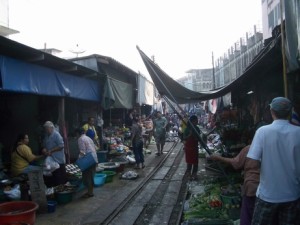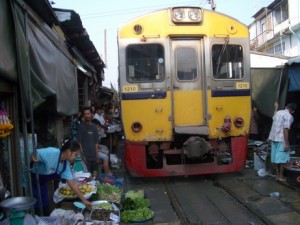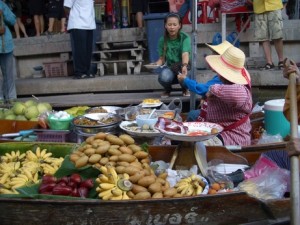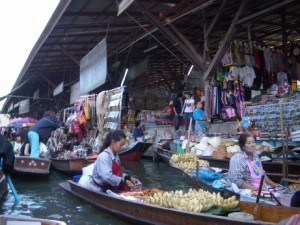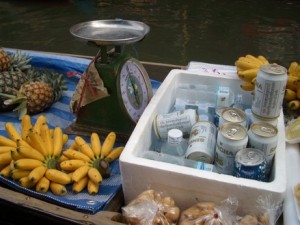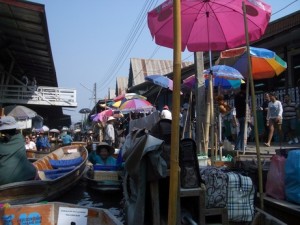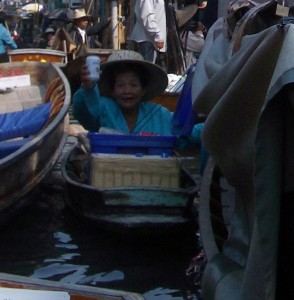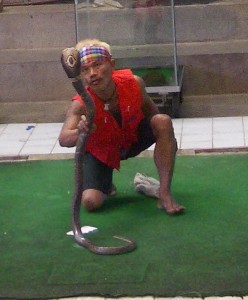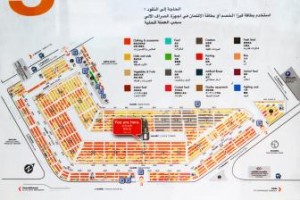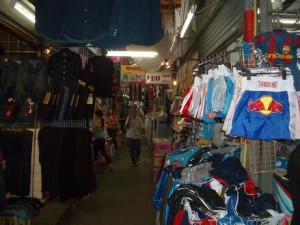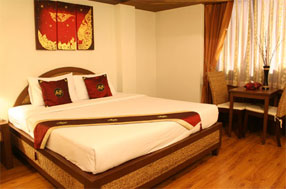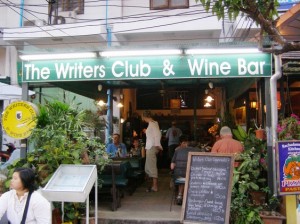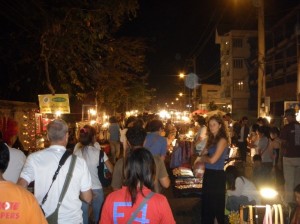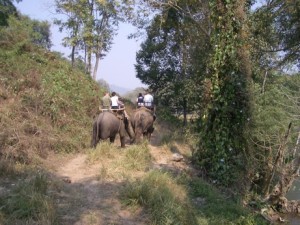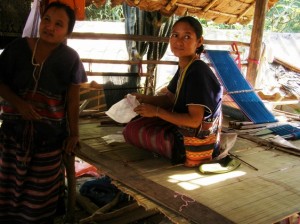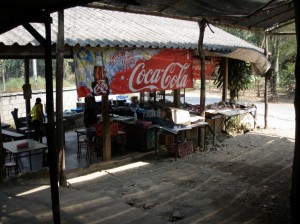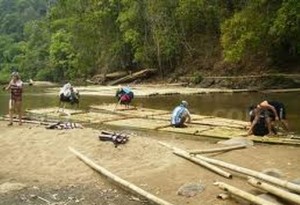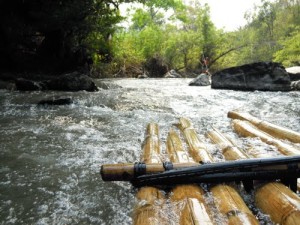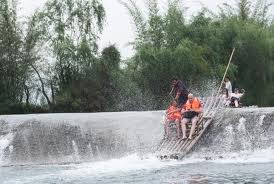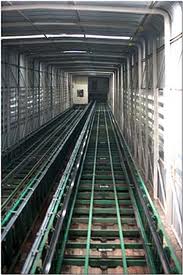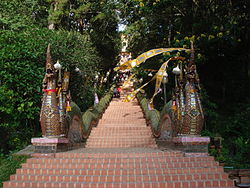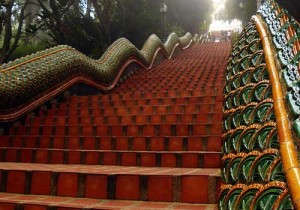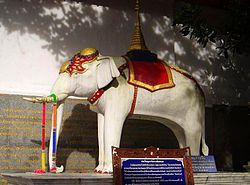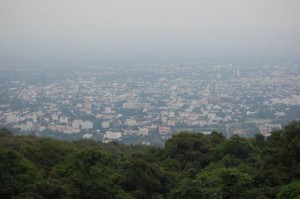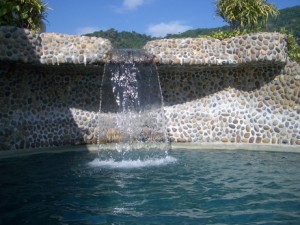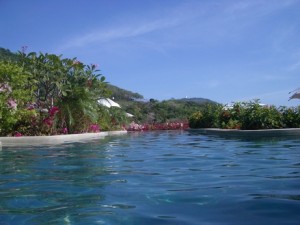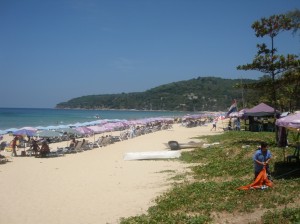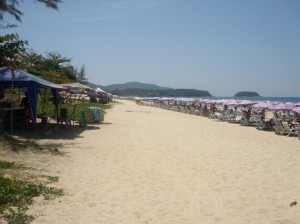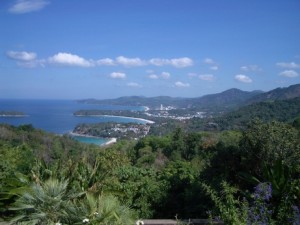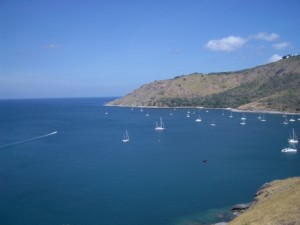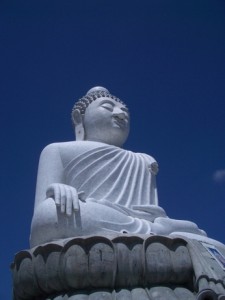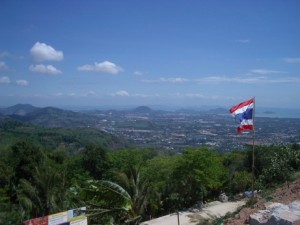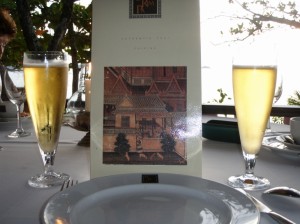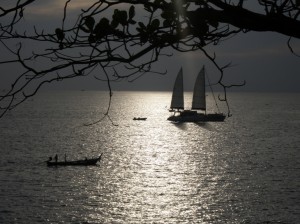2009
Shakespeare said that The Golden age is before us, not behind us!
That was good enough for me so this year we are off to Thailand.
For one reason and another this trip was only for four of us (two couples), rather than the normal group of eight. For my wife and I, it was to celebrate our 40th wedding anniversary, and we were happy to have two friends along with us to help us celebrate.
We flew Thai International from Sydney to Bangkok in a B 777/300, a very smooth flight.
The only odd thing that happened was that the cabin crew asked us to pull down the window shades so that people could sleep. The flight left Sydney at 08.55 am, and it was a Sydney originating flight, so the majority, if not all of the passengers would have been in bed asleep a few hours before check-in. Why would a passenger wish to sleep on a daylight flight after a good night’s sleep?
The vast Australian landscape could be seen below, and my wife always enjoys this view from the aircraft window, so there was quite a bit of muttering about dropping the blinds for such a daft reason. Even transit passengers from New Zealand travellers would have arrived in Sydney the night before, because the airport doesn’t open until 6.00 am. Regardless the flight was very good, and we enjoy flying with Thai International.
We had decided on a ‘small’ break of fourteen nights instead of our normal twenty one to twenty five nights. The largest cost being the flight when spread over more nights brings the daily cost of the holiday down considerably.
We arrived in Bangkok at 2.15 pm (local time) which is four hours behind Sydney during our summer months. Standard (winter) Sydney time is three hours ahead of Thailand. I’d arranged for our own transport, a small mini-bus to take us to our hotel, the Pullman Bangkok King Power. The ride in to the city was 35 minutes and gave us a glimpse of the volume of traffic in and around Bangkok.
I hoped to use the express train service, but found out that the opening was delayed, and it would not be available until 2010. So the Oriental Escape minibus was the best option being door to door, and it saved the hassle of a taxi from the bus station to the hotel if we had used the airport express bus service. The average price of a taxi from the airport was around 450 baht and the price of the minibus was 1200 baht, split between two couples, so for an extra 150 baht (about $5 per couple) we had far more room and our own driver waving a large sign to welcome us to Thailand. I couldn’t fault the staff that I dealt with over the Internet – very professional, and fast in replying to my questions. I have used them again in 2010 and the high service level was the same, plus I received a slight discount in 2010 for being a ‘regular’. https://www.orientalescape.com/thailand/transfer/index.html
On arrival at our hotel the doorman held the door open and pointed out the reception area. I mentioned that we had booked the Executive Floor, and all of a sudden a lady hurried over and took charge. The doorman must have made a sign of some sort because there is no way that she could have overheard my comment. We were escorted to the lifts and told not to worry about our bags. The lady then placed her ID card in the lift slot and we travelled none stop to the 20th Floor. Here we were offered cold drinks and cold face clothes, while the staff completed all the check-in procedures. Within a very short time we were escorted to our rooms where the facilities were explained.
Our room
The cost of the room, with access to the executive lounge, which included Happy Hour drinks & snacks (although the actual Happy Hour was two hours) was not to bad considering the cost of wine in Thailand. It is cheaper in some places to drink whisky rather than wine (even locally produce wine). I have no idea why wine is so expensive, other than very high taxes.Guests could use the lounge all day (tea, coffee etc complimentary) and each evening, after a day of sight seeing, the lounge was a place of calm and tranquility. The waiter/waitresses were always around, without being in your face, and the hot food was replenished frequently. After the first night we noticed that if a staff member had been on duty the previous evening he/she would remember what type of wine we liked and greet us with the offer of the same drink the following evening. Attention to detail showed in their training.
Executive Lounge
Staying on this floor was cheaper than a standard room, in a similar hotel in Australia, as long as you don’t take in to account the airfare.
The following day was a gentle start to the holiday. I’d arranged for a guide, via a company called Tour with Tong http://www.tourwithtong.com/index.htm , so that we could control what we wished to see, and if we grew tired we could end the tour. We paid an agreed fee for the day, on the understanding that we paid for our guide’s fares on public transport. As the fares for the transport system are inexpensive, that wasn’t a problem. I spent a lot of time asking various tour companies questions. In the end I honed it down to Tour with Tong, and Areerak Sriratu (nick name Kung) who would be our guide. Check the web site and you will find bio-details for all of Tong’s guides.
Kung arrived at the hotel at 8.00 am and we set off via the Skytrain to the river. She was very friendly (with out being too friendly) and happy to explain the transport system to us, and how to work out the best deal for the use of the Skytrain, depending on how many trips we wished to do a day, and whether to buy a daily rover or just pay for each trip separately. We found the Skytrain to be very efficient.
At the river we waited for the ferry to take us down river to the ferry stop close to the Grand Palace
While we waited for the ferry we saw large volumes of water hyacinth that has been washed down from the hills.
When you see the vegetation floating around the pier it looked thick enough to walk on – we didn’t try.
Ferry boat arriving
We were told to make sure our wives did not touch or brush against any of the priests, because this would make them unclean, and it takes the priest days to get ‘pure’ again. The packed ferryboat didn’t leave much room for females (not just our wives), not to be pushed or brush against a priest. Perhaps if it is accidental the ‘unclean’ part is ignored. After boarding, our ferry stopped about a kilometer down river to pick up and drop off passengers, and then it sailed further down river for about another kilometer and turned to stem the fast flowing river and tried to manoeuvre alongside the next stop. For some reason the pilot / helmsman could not get close enough for the bowman to throw a rope ashore. He tried several times – perhaps the river was too strong, so in the end he gave up, and carried on down river. Of course we wondered if he would be able to get alongside the stop that we required. Our fears were unfounded as it was much easier to get alongside our destination pier than the previous pier.
The walk from the pier to the Grand Palace entrance was about five minutes. We passed through a small market selling food and cold water. Everything was interesting as it was all so ‘foreign’. Reading the street signs and the advertising billboards was out of the question.
This is one of the entrances to the Grand Palace complex, but there is no way we could confirm this by reading the sign over the main door.
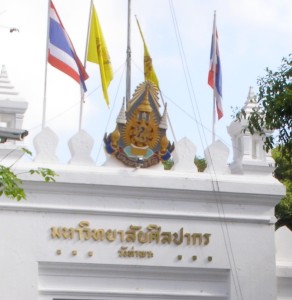 The coat of arms & flags came in handy, but we just followed our guide.
The coat of arms & flags came in handy, but we just followed our guide.
The Grand Palace and Wat Phra Kaew, or in English, the Temple of the Emerald Buddha, are a ‘must’ for anybody visiting Bangkok. The sheer size of the place, which is steeped in history, will be an experience not to be missed. The Temple and the Grand Palace are in the same complex, and it will take quite a long time to see everything. Kung gave us the history, and the background of many of the buildings and their meaning to the people of Thailand. She was able to answer all of our questions.
Main entrance
One of the many Temples
 Everything is very well looked after & carefully repaired.
Everything is very well looked after & carefully repaired.
There is very strong dress code for visiting the Grand Palace and the Temple of the Emerald Buddha. Make sure you are dressed appropriately, so as not to cause offence. We wore long pants and our wives wore long skirts. Tour with Tong supplied a suggestion sheet of cultural differences between our western society and Thai society. It covers dress code, tipping, car hire, driving, the position of the King to the people, and how well he is regarded, and many other helpful hints.
Buddhism is part of the Thai’s daily lives as is the monarchy – the Grand Palace, constructed in 1782
By late morning we were beginning to flag due to the heat, so Kung suggested that we make our way to the Wat Phra Chettuphon Wimon Mangkhlaram Ratchaworamahawihan or Reclining Buddha, which was a short distance from the Grand Palace. On the way we stopped for a snack and a cold drink at a pavement café – just what the doctor (Kung) ordered.
This Buddha is 15 mtrs high and 43 mtrs long.
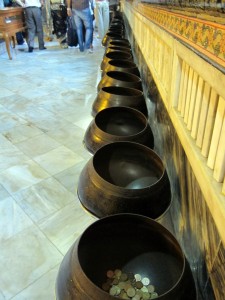 While we were viewing this Buddha we could hear the tinkling of metal hitting metal. It was the locals tossing coins in to one of the 108 bronze bowels. The 108 bowels indicated the 108 auspicious characters of Buddha.
While we were viewing this Buddha we could hear the tinkling of metal hitting metal. It was the locals tossing coins in to one of the 108 bronze bowels. The 108 bowels indicated the 108 auspicious characters of Buddha.
We only booked Kung for half a day, so we were back at our hotel just after 1.00 pm, hot and tired, but satisfied with what we had managed to see during the morning.
In the evening we had booked (over the Internet) a river cruise and meal on a converted rice barge. Seemed a good idea while we were in Sydney. We were placed near the stern, and every so often we would receive clouds of diesel fumes as the boat manoeuvred, and the wind caught the fumes. We did move to another table, but we had much the same problem, and as the barge was full we just had to endure the smell. It wasn’t a pleasant experience.
Forgetting about the diesel fuel smell, I doubt that we would repeat the rice barge as we found it expensive for what we received. It was very pleasant watching the sunset and the riverbank lighting up as we cruised up and down. Referring back to the Pullman lounge and my comment about the high price of wine; on the rice barge, in 2009 a 150 ml glass of wine was around $15 (this was the cheapest.) All prices are in baht at 2009 exchange rates), local beer was $6.50 and a gin and tonic was $10.00. The cruise lasted from 6.00 pm to 8.00 pm, and I am sorry to say the food was ‘ordinary’.
The following day was a full day of touring the River Kwai.
During the war the Americans bombed the real bridge on the river Kwai. The centre parts of the bridge (the flat bits) are new, and the original part of the bridge has the curved sides. This is bridge # 277.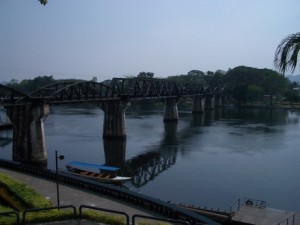
We were able to walk on the bridge; it is a rail bridge only, and not available for road transport.
We also visited the JEATH Museum – Japan – English – Australia – Thailand – Holland. Where we could see a reconstruction of a POW hut. Inside the hut one can see how the prisoners lived (and died). Prison artists have recreated the hell in which they lived.
Following on from the JEATH Museum we visited the Kanchanaburi War Cemetery – a very emotional place as you walk passed hundreds of plaques, which lists the name, rank, regiment, age and date of death.
Later we drove to the village of Nam Tok, which is the end of the line for the railway. The railway used to go further, towards Burma, but the part after Nam Tok is no longer in use. We walked along the Wang Pho viaduct, which had been built by POWs in 17 days, and is still in use by trains visiting Nam Tok. Along side the viaduct was a large cave. This cave was used by the POWs as a ‘hospital’ it is now a Buddhist Temple.
The Viaduct
The Viaduct
The ‘Hospital’, which is now a Buddhist Temple in remembrance.
After leaving the Nam Tok area we drove to the Tiger Temple. It was quite an experience being so close to the tiger and being able to walk with them – as long as we only touched the middle of their backs. I was glad that we did the afternoon visit after the tiger had been fed and watered and were ready for a quiet nap. They all seemed to know what was required of them, but I wasn’t going to treat them with anything but respect – they were still wild animals.
I was given strict instructions as to where I could touch the animal.
I could feel the one on the right looking at me – perhaps they could sense my disquiet. 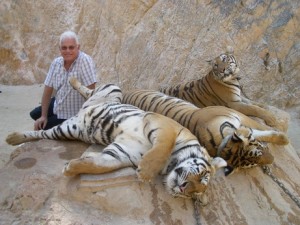
This area was an old quarry, where the tigers were allowed to have a doze in the heat of the day. I must admit, I never felt dozy around those animals. At the end of the Tiger Temple tour we were asked if we wished to visit other areas close bye, but we knew that the drive back would be long and we would hit the rush hour, so we voted to return to our hotel.
With hindsight we should have left the Tiger Temple earlier.
From the outskirts it took us over an hour to do about ten kilometers.
Kung was at the hotel again the next day –
all bright and early – 7.00 am!
Off again, but this time to see the salt pans, floating market, snake charmers and wood work display by local artists. On the way Kung asked if we’d seen the railway market – we hadn’t, nor had we heard of it, although I’d researched ‘what to see in Thailand’ etc and had not come across the railway market. This market is now on the ‘must see’ list of many tourists as it has become very popular.
Thai salt is not mined, but produced by seawater evaporation.
The next stop was Maeklong Station. The train has to cross a road to reach this station so the people have turned the railway track area, before the rail cross the road in to a market.
I took the picture on the left while standing on the platform of the station facing the market across the road. You can see the railway line, and the shoppers using the centre of the line, in the market, as a walkway.
The market sells everything that can be eaten – From live fish killed while you wait
to bugs of the day if that is your choice
Or perhaps small live crabs, tied so they don’t run away.
But everything changes when they hear the train approaching – drop or pull up the awnings and shade cloth. Clear the sale goods off the line and stand back.
The train slows down, but doesn’t stop, and it has right of way – might is right. 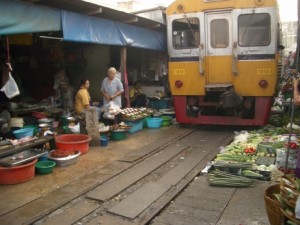
Move on to another market – the Floating Market.
Not just tourists buy here.
And of course the necessities of life are also offered – Singha Beer
Bangkok is not the only place that has a traffic jam.
The lady in the centre has the right idea of what to do in a traffic jam. Beers all round.
From the floating market we moved on to the cobra show.
Sometime the cobra doesn’t wish to play 
On to the woodcarving and the making of furniture at the Thai Handicraft Centre. The other couple travelling with us used to have a business making furniture, so my friend was very interested in this visit.
We learned from the previous day’s experience, and left early enough for our return trip, so as to not waste hours in traffic.
If ever you are in Bangkok, and you like seafood, try and visit a restaurant called Kuang Sea Foods, 107/13 Soi Rangnam, Samsen Nai, Phaya Thai, Bangkok. Personally seafood is not my choice of a main dish, but my wife and the other couple liked the food so much they dragged me back another night. BTW – I had the pad Thai chicken both nights, beautiful.
We had a sleep in then next day as the market didn’t open until after 9.00 am – Chatuchak weekend market is huge; some websites tell you that there are 15,000 stalls, others state there are 8,000 as if the difference was going to make or break the visit. You’ll not be there long enough to visit every stall. They sell everything from books through to toys, clothing, hardware, food, furniture, plants – you name it they have it. Get there early because as the day heats up and the crowds grow, it can become just too much for a westerner. As you enter the area make sure you pick up a map of the stalls. The various stalls selling similar products e.g hardware or books are all gathered in the same area. If you are after clothes read the map and save yourself the hassle of being in the gardening area. Fortunately they do have a ‘husband’ area, which is cool and they serve ice-cold beer. As long as your wife can read a map, you’ll be happy.
Market map Stalls
We stayed for around an hour and a half, which was enough, before we made our way to an air-conditioned mall for a light lunch.
In some of the malls they have a system of buying tickets of various value from a central point – the tickets have the same value as the cash that you hand over – a blue ticket might equal 50 bht – you do not lose on the ‘exchange’. You then buy your food and drink using the tickets, and any ticket left over can be exchanged for real money at the end of the meal. None of the stalls handle cash – perhaps it is a security issue or a health issue, Thai money notes can be grubby.
Off to Chiang Mai the following morning, which is about an hour’s flight.
We decide on a boutique style hotel called Sira Boutique Hotel http://siraboutique.com/ we enjoyed our stay. The owner’s were British, and lived on the premises; we picked the hotel for location & price, not the nationality of the owner; but because of the owner’s nationality we were able to gain a lot more from the stay than if it had been owned by a Thai. The owner was able to explain the politics, (in comparison to the British / Australian system), the position of the King, and the love that the people had for their King. The owner was quite happy to sit and have a drink with us, while he answered our questions.
Our room
It was a short walk to the night market, which had plenty to see, and a number of places where one can eat. I particularly liked the food at The Writers Club.
Through the hotel we were able to book a day out – elephant riding, rafting, visiting a local village, all transport in an air-conditioned minibus, lunch and a guide, all for about $40 per person. It was good value.
Each elephant carried two people, plus the handler who sat across the animal’s neck. For the record ours was called Jennifer, and whenever Jennifer felt hungry she would stop and help herself to a bunch of leaves or large twigs to chew on her walk around the area. When we returned to our starting point we were encouraged to feed Jennifer with bananas. The trip on the elephant was about 40 minutes, which took us across a river – we realised later that we’d crossed this river on Jennifer as we rafted our way down stream.
From the elephant walk we made our way to a local village to see how various items were made and of course we had the chance to buy any that we wished.
After the village visit we moved on to our lunch stop. The food was vegetarian and very tasty and hot, in both spice and heat. The food was not sitting around waiting for us, but was cooked after we’d given our order. The meal included rice and a soft drink. We had the ability to buy a beer (cheap) if we wished. The restaurant, come café, was out in the bush, rather than in a town. It would not be the place to go on a Saturday night, but the food was very good.
We were advised that we would not get wet when rafting, because we would be sitting on small seats that would keep our clothes from being wet. That was a joke!
We watched as the rafts were being created from poles of bamboo. The rafts are floated down river and dismantled at the end of the experience to be brought back up to the top and reassembled. Didn’t matter how hard I looked I could not see a seat. Our mini-bus guide advised us to leave our cameras and anything else that we did not wish to get wet in the bus and he would look after everything. I left everything except the shorts & shirt that I was wearing.
Each raft could take four people and we had to sit down and balance the ‘raft’ so as not to be tipped in to the water. Of course as soon as we sat down, and all four of us were on board, the water came through the cracks between the poles. A local ‘boatman’ poled the raft in to the middle and guided it down the river. Other rafts followed and a competition began between the ‘boatmen’ to see who could cause the largest splash by using their punting pole, to make sure that all the passengers we soaking wet. It was all in good fun, and all of the passengers on each of the rafts joined in to create larger splashes. On the way down we realised that we were passing the same place where we’d crossed the river on the back of Jennifer the elephant. Fortunately she was not around. Further down the river we could hear rushing water and knew that we were approaching rapids.
The water becomes choppier and any thought of keeping dry was forgotten. The experience was great and we all enjoyed ‘going over the top’.
At the end of the ‘run’ we climbed the riverbank to be met by our guide and driver. The hot sun was very pleasant as we attempted to dry our clothing and ourselves. We managed to dry our shirts somewhat, but only until they were just damp, and we squeezed as much water as we could from our shorts, but the drive back to the hotel was uncomfortable because the air-conditioning, in the mini-bus, was very efficient.
The following day we visited the Doi Suthep Temple, which is about fifteen kilometers outside Chiang Mai. To reach the temple we used the funicular tram, on account of it being over 1600 meters above sea level, and we didn’t wish to climb the 316 steps (some say 309, I didn’t count them) to reach the top. Using the steps to get to the top it is free, but for $1 it was easier to use the tram – a return ticket was $1.60
Railway
309 or 316 steps to the top, whatever the true count is, it was too hot to attempt the climb.
It is said that the temple was founded in 1383. Visiting the temple is easy, and while there you can read its history and the reason why it is placed in such a position, and the origin of the white elephant. We did not use a tourist guide as we had been advised that it is easy and inexpensive to get to the base of the hill by taxi, and to understand everything about the place. It was easy and it was interesting. If you are in to photography the view from the top is spectacular and a photographer’s delight. My effort doesn’t do the view justice.
There is a small market at the base of the hill selling the usual souvenirs. A spot of souvenir shopping in the afternoon and that was the end of our visit to Chiang Mai.
The flight from Chiang Mai to the island of Phuket was pleasant and we landed mid afternoon to be met by our hotel’s transport. It was about an hours ride from the airport to the hotel at Karon Beach. Phuket Island is a similar size to Singapore.
Our hotel, Pacific Club and Spa http://www.pacific-club-phuket.com/ had a Mexican, come Mediterranean feel to it, with a touch of Thai. The rooms were quite large and the balcony allowed us to have our own Happy Hour overlooking the ocean. The roof top pool was just right after the flight & the hour drive, even though the transport was air-conditioned.
We had five nights, four days on the island of Phuket. The hotel is built on the side of a hill so the views were across the rooftops to the ocean. The small height above sea level gave us just that little bit of cool wind in the evening, which allowed us to sit on the balcony and enjoy the evening.
The beach, which was about a five or six minute walking from the hotel was very popular with northern Europeans, who seemed to spend all their time trying to become lobsters. Many ignored the umbrellas and lay for long periods before turning and basting their other side. Every day we were in Karon it was around 35 c, the European skin didn’t stand a chance, and we could see the self inflicted damage as these upright lobsters held shirts and blouses away from their shoulders while walking to their hotels.
It was a short tuk tuk ride from Karon to Patong town, which is the main tourist town of Phuket. We did not find it an attractive town, as it was dirty and seemed too full of people trying to sell us articles that we didn’t want. The beach looked OK, but again it had a lot of rubbish, which had been washed ashore by the tide. There are many other beaches around Phuket that are much better than Patong beach.
Beside the tourist stalls and the open walled bars it was a short walk to Jungceylon, one of the main shopping malls – all air-conditioned, but still a shopping mall.
We had been warned about rip off merchants who offered tours of the island and charged like wounded bulls. The hotel offered their own driver and vehicle, for a fair hourly rate and were happy to charge it to our room.
Views from two lookout points.
We covered quite a lot in a short time from scenic viewpoints, to small villages and seeing the new Buddha being created. While we out and about we stopped at Phuket town because we wanted to alter our airline tickets and bring forward our departure to an earlier flight – about an hour earlier. The lady was helpful, but wanted to charge us another $150 for the change of timing, which was more than actual ticket cost in the first place. We refused her generous offer.
Not far from the airline offices we came across Rabiang Thai restaurant and decided to have lunch. They service was very good and the friendliness of the staff made one feel welcome. Above all the food tasted wonderful.
Known as the big Buddha, 135 tons of concrete, covered in Burmese white jade. Built on top of a 400 mtr hill, it is 45 mtrs high and 25 mtrs across, and can be seen from most places on the island, it dominates the skyline. There are two statues of Buddha on this hill. The smaller Buddha being at the foot of the hill along with various buildings where one can read the history of the Big Buddha and also read about Buddhism. Both statues have been built with donations from the Thai people and tourists. 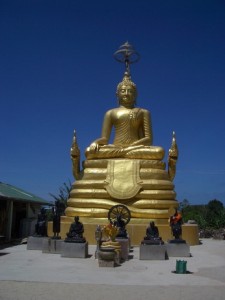
Visiting the Big Buddha was interesting and it gave us marvelous views of Phuket town.
The Big Buddha is behind me as I took this photograph.
The day before we left Phuket was our 40th wedding anniversary so we booked the evening meal at Baan Rim Pa. This restaurant is on a small peninsular that juts out in to the sea. The views are to die for, particularly as the sunsets. Our cameras never stopped.
Our two drinks as we studied the menu.
As the sun sets it seemed to leach colour from the scenery. As we watched the sun set the bar behind us started to come to life. They have a piano, which a pianist plays as the evening progresses.
Overall I was disappointed with our meal. It was traditional Thai food accompanied by beer & wine. I ordered the same dish at the Baan Rim Pa restaurant that I’d ordered in Bangkok, at a small roadside restaurant. IMO -The Bangkok roadside restaurant food was better, and cost about ten percent of the price of the Baan Rim Pa restaurant. I am aware that they have a global reputation as one of the best restaurants in Thailand, and they have a prime location, but charging higher prices for a bottle of local beer than restaurants do in Sydney for Australian local beer is off putting. A glass of wine was about $23, and it was no better than a ‘cleanskin’ bought from a Sydney outlet for $5 a bottle. At the end of the meal when I was presented with the bill, I felt ripped off. I suppose this is one way to remember ones 40th wedding anniversary.
After leaving the restaurant we walked down to Patong town and up Bangla Road to see what it was like at night. The ‘sharp’ edges the bars in daylight were dulled by the many coloured lights, which added a festive feel to the street. It reminded me of certain places I’d seen in Japan during the 60’s. It was an experience for our wives.
The following day was time to go home. We left the hotel in plenty of time to get to the airport. I’d allowed about an hour and three quarters just in case of traffic problems. We arrived at the airport after about an hours drive and queued to check-in. We checked our baggage through to Sydney and received our boarding passes for both the domestic flight to Bangkok, and the international flight to Sydney. All being well we would have two hours to kill at Bangkok airport. The check-in went smoothly and we moved off to emigration and security.
Passport control and security was six or more lines in chaos (they kept changing) located in a very small area, all the lines were queuing to pass through passport control. The control officers had all the time in the world, so it wasn’t long before some of the crowd became concerned that they would miss their flights. We queued for well over an hour before being passed through the system, and then we had to hurry to the aircraft.
On arrival in Bangkok many of us who were transit international passengers were bused to the terminal. This required us to pass through no less than five security checks before we arrived in a final passenger transit area, where we queued once again so as to pass through another security barrier before reaching the final boarding gate. The queue was long and ‘fat’ as people dragged children and wheeled on-board bags behind them. As we drew close to the front of the line we heard shouting, and placards were being waved with our flight number, and our names scrawled across the placard. I waved at the ground staff and shouted over the hubbub. We were then grabbed, and pushed through the security system and downstairs towards the departure gate.
At the bottom of the stairs just before the gate, one lady stated that we were late and that the plane was being delayed and held for us. It came across as an accusation that it was our fault and we were not doing the ‘right thing.’ Let’s just say I was impolite to this lady when I commented on the inefficiency of Phuket airport, and Bangkok airport and the Thai security system.
As we boarded, the door closed and the engines grew louder as the plane began to taxi. My wife and I were allocated two of the three emergency row seats (with the middle seat being empty). So the experience wasn’t all that bad after all, thank you Thai International!


